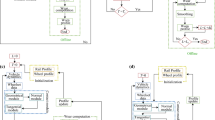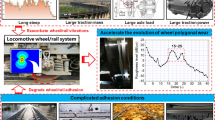Abstract
The prediction of the wheel wear is a fundamental problem in heavy haul railway. A numerical methodology is introduced to simulate the wheel wear evolution of heavy haul freight car. The methodology includes the spatial coupling dynamics of vehicle and track, the three-dimensional rolling contact analysis of wheel-rail, the Specht’s material wear model, and the strategy for reproducing the actual operation conditions of railway. The freight vehicle is treated as a full 3D rigid multi-body model. Every component is built detailedly and various contact interactions between parts are accurately simulated, taking into account the real clearances. The wheel-rail rolling contact calculation is carried out based on Hertz’s theory and Kalker’s FASTSIM algorithm. The track model is built based on field measurements. The material loss due to wear is evaluated according to the Specht’s model in which the wear coefficient varies with the wear intensity. In order to exactly reproduce the actual operating conditions of railway, dynamic simulations are performed separately for all possible track conditions and running velocities in each iterative step. Dimensionless weight coefficients are introduced that determine the ratios of different cases and are obtained through site survey. For the wheel profile updating, an adaptive step strategy based on the wear depth is introduced, which can effectively improve the reliability and stability of numerical calculation. At last, the wear evolution laws are studied by the numerical model for different wheels of heavy haul freight vehicle running in curves. The results show that the wear of the front wheelset is more serious than that of the rear wheelset for one bogie, and the difference is more obvious for the outer wheels. The wear of the outer wheels is severer than that of the inner wheels. The wear of outer wheels mainly distributes near the flange and the root; while the wear of inner wheels mainly distributes around the nominal rolling circle. For the outer wheel of front wheelset of each bogie, the development of wear is gradually concentrated on the flange and the developing speed increases continually with the increase of traveled distance.
Similar content being viewed by others
References
PEARCE T G, SHERRATT N D. Prediction of wheel profile wear [J]. Wear, 1991, 144(1/2): 343–351.
LI Z L, KALKER J J, WIERSMA P K, SNIJDERS E R. Non-hertzian wheel-rail wear simulation in vehicle dynamical systems [C]// The 4th International Conference on Railway Bogies and Running Gears. Budapest, 1998: 187–196.
BRAGHIN F, BRUNI S, RESTA F. Wear of railway wheel profiles: A comparison between experimental results and a mathematical model [J]. Vehicle System Dynamics, 2002, 37(supplement): 478–489.
KALKER J J. Three-dimensional elastic bodies in rolling contact [M]. Dordrecht: Kluwer Academic Publishers, 1990.
BRAGHIN F, LEWIS R, DWYER-JOYCE R S, BRUNI S. A mathematical model to predict railway wheel profile evolution due to wear [J]. Wear, 2006, 261(11/12): 1253–1264.
JENDEL T. Prediction of wheel profile wear-comparisons with field measurements [J]. Wear, 2002, 253(1/2): 89–99.
ENBLOM R. Simulation of wheel and rail profile evolution-wear modeling and validation [D]. Stockholm: Royal Institute of Technology, 2004.
ENBLOM R, BERG M. Simulation of railway wheel profile development due to wear: Influence of disc braking and contact environment [J]. Wear, 2005, 258(7/8): 1055–1063.
ENBLOM R, BERG M. Impact of non-elliptic contact modeling in wheel wear simulation [J]. Wear, 2008, 265(9/10): 1532–1541.
WARD A, LEWIS R, DWYER-JOYCE R S. Incorporating a railway wheel wear model into multi-body simulations of wheelset dynamics [J]. Iridology Series, 2003, 41: 367–376.
LI Xia, JIN Xue-song, WEN Ze-feng, CUI Da-bin, ZHANG Wen-hua. A new integrated model to predict wheel profile evolution due to wear [J]. Wear, 2011, 271(1/2): 227–237.
LI Xia, JIN Xue-song, HU Dong. Theoretical model and numerical method of wheel profile wear [J]. Chinese Journal of Mechanical Engineering, 2009, 45(9): 193–200. (in Chinese)
ZHAI Wan-ming. Vehicle-track coupling dynamics [M]. Beijing: Science Press, 2007. (in Chinese)
IGNESTI M, MALVEZZI M, MARINI L, MELI E, RINDI A. Development of a wear model for the prediction of wheel and rail profile evolution in railway systems [J]. Wear, 2012, 284/285: 1–17.
MALVEZZI M, MELI E, FALOMI S, RINDI A. Determination of wheel-rail contact points with semianalytic methods [J]. Multibody System Dynamics, 2008, 20(4): 327–358.
AUCIELLO J, MELI E, FALOMI S, MALVEZZI M. Dynamic simulation of railway vehicles: wheel/rail contact analysis [J]. Vehicle System Dynamics, 2009, 47(7): 867–899.
KOVALEV R, LYSIKOV N, MIKHEEV G, POGORELOV D, SIMONOV V, YAZYKOV V, ZAKHAROV S, ZHAROV I, GORYACHEVA I, SOSHENKOV S, TORSKAYA E. Freight car models and their computer-aided dynamic analysis [J]. Multibody System Dynamics, 2009, 22(4): 399–423.
POGORELOV D, SIMONOV V, KOVALEV R, YAZYKOV V, LYSIKOV N. Simulation of freight car dynamics: mathematical models, safety, wear [C]// The 2nd International Conference on Recent Advances in Railway Engineering. Tehran: Iran University of Science and Technology, 2009.
POGORELOV D, et al. Simulation of rail vehicle dynamics-user’s manual [M]. Bryansk: Bryansk State Technical University, 2012.
POGORELOV D, et al. Mechanical system as an object for modeling-user’s manual [M]. Bryansk: Bryansk State Technical University, 2012.
KRAUS P R, FREDRIKSSON A, KUMAR V. Modeling of frictional contacts for dynamic simulation [C]// IROS 1997 Workshop on Dynamic Simulation: Methods and Applications. Grenoble, France: 1997.
MALVEZZI M, MELI E, PAPINI S, MALVEIII M, MELI E, PAPINI S, PUGI L. Parametric models of railway systems for real-time applications [C]// Multibody Dynamics. Milano: Politecnicodi Milano, 2007.
HERTZ H. The contact of elastic solids [J]. Journal fur Die Reine und Angewandte Mathematik, 1881, 92: 156–171.
ANTOINE J F, VISA C, SAUVEY C, ANTOINE J F, VISA C, SAUVEY C, ABBA G. Approximate analytical model for hertzian elliptical contact problems [J]. Journal of Tribology, 2006, 128(3): 660–664.
KALKER J J. A fast algorithm for the simplified theory of rolling contact [J]. Vehicle System Dynamics, 1982, 11(1): 1–13.
GAO Liang, YIN Hui, XIAO Hong, XIN Tao. A device for testing the ballast stiffness of ballast track: China, ZL200910078471.3 [P]. 2011-01.
GAO Liang, YIN Hui, CAI Xiao-pei, QU Cun. A device for testing the lateral resistance of ballast bed: China, ZL200920105871.4 [P]. 2009-12.
POGORELOV D, et al. Railway wheel and rail profile wear prediction module: user’s manual [M]. Bryansk: Bryansk State Technical University, 2012.
SPECHT W. New particulars of wear of heavy railway carriage wheels [J]. Glasers Annalen, 1987, 9: 271–280.
LI Xia, WEN Ze-feng, JIN Xue-song. Investigation into wheel wear and fatigue of heavy-haul railways [J]. Journal of the China Railway Society, 2011, 33(3): 28–34. (in Chinese)
DING Jun-jun, LI Fu, HUANG Yun-hua. Analysis of the wheel wear model based on the creep mechanism [J]. China Railway Science, 2010, 31(5): 66–72. (in Chinese)
Author information
Authors and Affiliations
Corresponding author
Additional information
Foundation item: Project(U1234211) supported of the National Natural Science Foundation of China; Project(20120009110020) supported by the Specialized Research Fund for Ph.D. Programs of Foundation of Ministry of Education of China; Project(SHGF-11-32) supported the Scientific and Technological Innovation Project of China Shenhua Energy Company Limited
Rights and permissions
About this article
Cite this article
Wang, P., Gao, L. Numerical simulation of wheel wear evolution for heavy haul railway. J. Cent. South Univ. 22, 196–207 (2015). https://doi.org/10.1007/s11771-015-2510-1
Received:
Accepted:
Published:
Issue Date:
DOI: https://doi.org/10.1007/s11771-015-2510-1




